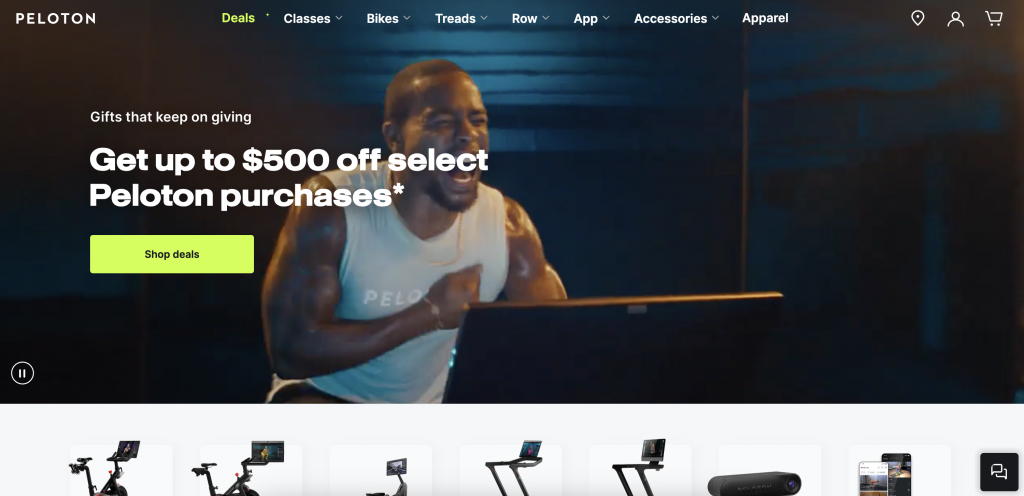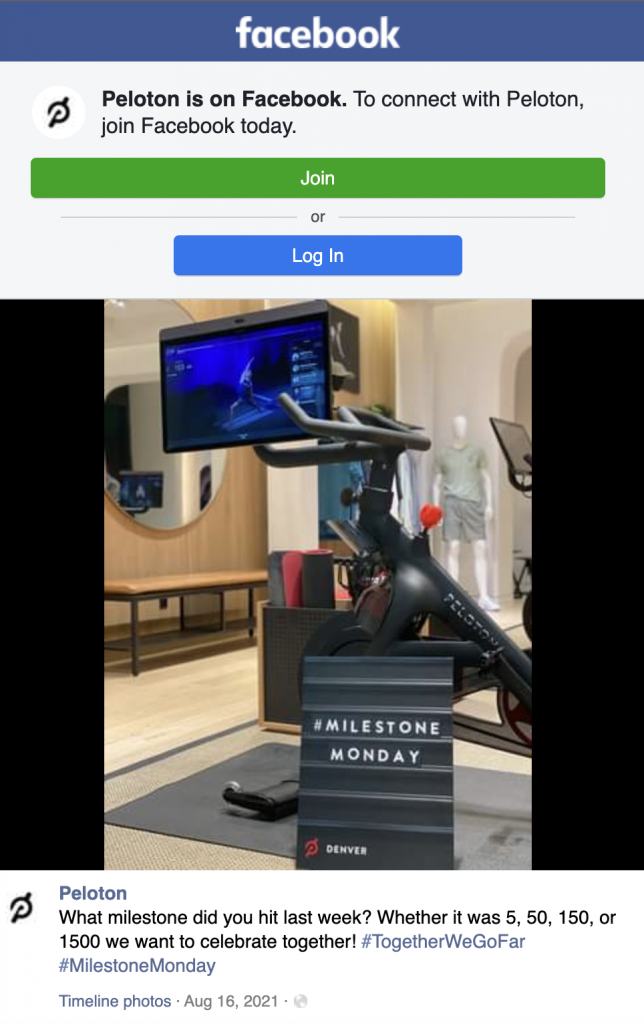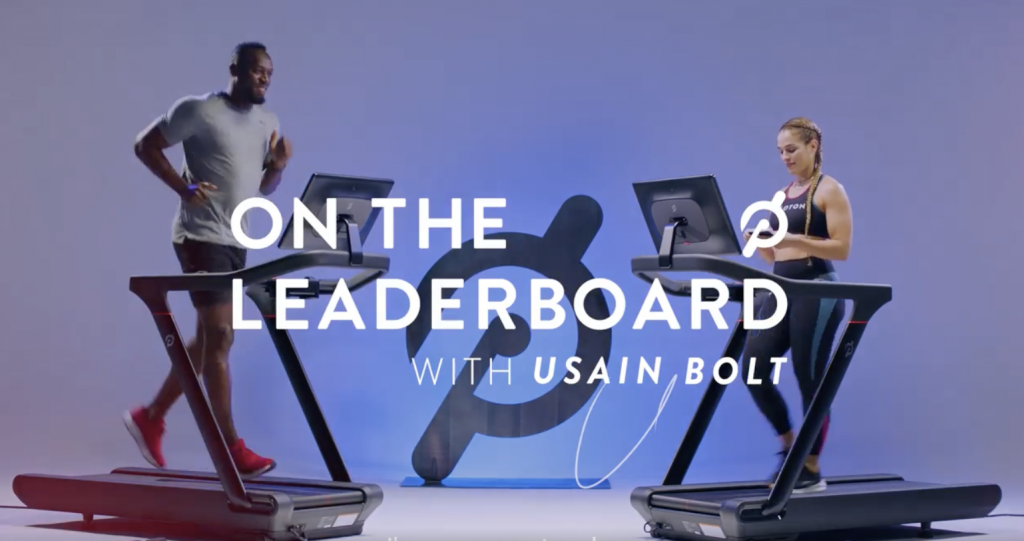blog»Digital Marketing»Pedal to the Top: 5 Game-Changing Marketing Lessons from Peloton

Pedal to the Top: 5 Game-Changing Marketing Lessons from Peloton
2023/12/11
You can read this article in about 41 minutes
Introduction to Peloton
In the dynamic landscape of the fitness industry, few brands have managed to pedal their way to the forefront of innovation and market influence quite like Peloton. Known for its high-end, interactive exercise equipment and streaming workout classes, Peloton has not just entered the market—it has revolutionized it. This revolution goes beyond just a smart exercise bike; it’s a testament to the power of savvy marketing, community building, and technological integration.

For marketing managers, Peloton stands as a beacon of inspiration, a case study rich with lessons on not just surviving, but thriving in a competitive landscape. In this exploration, we dive into the heart of Peloton’s marketing strategy, unraveling the top five learnings that have fueled their journey. From groundbreaking campaigns to adaptive marketing techniques, these insights offer a roadmap for innovation and success.
As we pedal through these insights, remember that the tone is casual enough to keep you engaged, but professional enough to respect the depth of the strategies discussed. So, strap on your cycling shoes and prepare for an enlightening ride through the marketing triumphs of Peloton.
The Genesis of Peloton: From Concept to Fitness Revolution
Before Peloton became synonymous with at-home fitness, it started as a bold idea in the minds of its founders. The journey began in 2012, when John Foley, a former Barnes & Noble executive with a passion for fitness, noticed a gap in the market. He envisioned a way for busy individuals to have access to boutique-style, high-energy, and community-driven spin classes without the need to visit a studio.

Foley, along with his co-founders, Tom Cortese, Hisao Kushi, Yony Feng, and Graham Stanton, embarked on a mission to merge high-quality fitness equipment with the burgeoning world of digital streaming. Their goal was clear: to create a product that offered the convenience of home use without compromising the quality of the workout experience.
The early days were challenging. The concept of a connected home exercise bike was new and untested, and it took considerable effort to convince investors. However, the founders’ persistence paid off. In 2013, Peloton launched a Kickstarter campaign, which not only provided the necessary funding but also validated the market demand for their innovative product.
Kickstarter
For marketing managers looking for a masterclass in crowdfunding success, Peloton’s Kickstarter campaign in July 2013 is a case study in strategic planning and market resonance. Launching with a modest goal of $250,000, Peloton aimed to revolutionize the indoor cycling experience. This fund was not just a number; it was a strategic investment in developing a sophisticated machine manufacturing process for their innovative exercise bikes. Moreover, it was a calculated move to secure vital components like steel, aluminum, plastic, and microchips ahead of time, ensuring a smooth production runway.
What happened next was not just success but a testament to market validation. The campaign didn’t just meet its target; it soared past it, amassing $307,332 from 297 backers. This overwhelming response was more than a financial win; it was a clear signal of the market’s readiness for a disruptive change in the fitness industry. Peloton’s blend of cutting-edge hardware, intuitive software, and immersive content, all integrated into a sleek streaming platform, resonated deeply with consumers.
This campaign is a blueprint for marketing managers on how to not only capture the market’s attention but also to hold it, turning a startup idea into a fitness revolution. It’s a story of how understanding market needs and innovatively addressing them can create not just a product, but a movement.

The first bike
The first Peloton bike wasn’t just a piece of exercise equipment; it was a groundbreaking fusion of technology and fitness. With its sleek, sturdy frame and comfortable seat, the standout feature was undoubtedly the 22-inch touchscreen. But Peloton’s innovation went far beyond this display. The bike integrated advanced software that allowed users to not only stream live and on-demand classes from top-notch instructors but also track their fitness progress, access a wide array of metrics, and receive real-time feedback, transforming the home workout experience.
As Peloton grew, so did its offerings. Beyond the bike, the company expanded into treadmills and a variety of online fitness classes, including yoga, strength training, and meditation. This expansion was a testament to Peloton’s commitment to holistic wellness and its understanding of evolving consumer needs.

In just a few years, Peloton transformed from a startup idea into a fitness empire, redefining the way people exercise and interact with fitness technology. Its success was a combination of foresight, innovation, and an unwavering commitment to community—a true revolution in the fitness industry.
Peloton’s Market Disruption
In a world where fitness trends come and go with the seasons, Peloton has done something extraordinary — it has not just entered the home fitness market, it has utterly disrupted it. The company’s unique blend of cutting-edge technology, live and on-demand streaming content, and community engagement has redefined what it means to ‘work out at home’. Peloton’s innovative model has not only captured the imagination of fitness enthusiasts around the globe but has also shifted consumer behavior and expectations in profound ways.
Redefining Home Fitness
The traditional image of home fitness equipment as bulky machines tucked away in a corner, collecting dust, was completely shattered by Peloton’s sleek design and interactive capabilities. Their stationary bike, with its immersive touchscreen, allowed users to participate in live classes, complete with real-time encouragement from top-tier instructors. This wasn’t just a technological leap; it was a new form of entertainment, socialization, and fitness all rolled into one.

Peloton’s content strategy was equally innovative. Instead of a one-size-fits-all approach, they offered a variety of classes catering to different fitness levels, musical tastes, and workout preferences. This personalization made users feel like they were part of something larger than themselves — a community of like-minded individuals all striving for better health.
Impacting the Fitness Industry and Consumer Behavior
The ripple effect of Peloton’s approach was felt across the entire fitness industry. Gym memberships were no longer the only option for a high-quality workout experience. Peloton proved that users were willing to invest in a premium home exercise platform if it offered value beyond physical equipment. This shift led to increased competition and innovation within the industry as traditional and new players alike sought to capture a piece of the at-home fitness market.
Consumer behavior also evolved. The convenience of being able to join a live spin class from the comfort of one’s home, at any time, changed the way people scheduled and prioritized their workouts. The integration of community features, like leaderboards and live metrics, leveraged the naturally competitive and social aspects of fitness, keeping users motivated and engaged.
Actions Taken by Peloton
Peloton’s disruption of the market was no accident; it was the result of a series of deliberate and strategic actions. For starters, they invested heavily in technology that could seamlessly integrate the in-studio experience with the home environment. They prioritized content creation, building a team of charismatic instructors who became celebrity figures in their own right.
Marketing played a crucial role as well. Peloton’s campaigns were aspirational yet accessible, showcasing real people making real progress. They weren’t selling a product; they were selling a lifestyle. Additionally, Peloton capitalized on user data to optimize their offerings and provide a personalized experience, which further solidified user loyalty.
In conclusion, Peloton’s market disruption is a textbook example of how a company can enter a traditional space and turn it on its head through innovation, quality content, and an unwavering focus on the customer experience.
Learning 1: Innovating the Product Experience
Peloton’s success can be attributed to many factors, but none more so than its unyielding commitment to innovating the product experience. At the intersection of technology and fitness, Peloton carved out a previously unexplored niche, harnessing the power of digital advancements to revolutionize personal fitness.
The Integration of Technology and Fitness
Peloton’s genius lies in its ability to recognize and capitalize on the potential of technology to enhance the fitness experience. By integrating smart features into their fitness equipment, they’ve transformed the solitary act of exercising at home into an interactive and engaging experience. The Peloton Bike, with its sleek design and immersive touch screen, is not just a piece of exercise machinery; it’s a gateway to a virtual world of fitness.
This technological integration allowed for an unprecedented level of interactivity. Users are not just working out; they are part of a live leaderboard, they can track their progress over time, and they can connect with friends and strangers alike. This is the gamification of exercise, where every pedal stroke moves you up in rank, turning the grind of daily exercise into a fun, addictive experience.
Case Study: Peloton Bike and Interactive Classes
The Peloton Bike stands as a testament to the company’s innovative approach. It’s a case study of how to make a product do more than its basic function. The bike is equipped with a high-definition screen that streams classes from some of the most charismatic and skilled instructors in the fitness world. These instructors don’t just lead a class; they create an immersive experience that makes users forget they are in their living room and not in a high-energy studio.

The interactive classes are at the core of the Peloton experience. They motivate a group class with the personal attention of a private session. The classes range from live sessions where users can compete in real-time against others, to on-demand options that fit any schedule. The technology tracks every aspect of the workout, providing users with detailed metrics on their performance. This level of detail ensures that users are not just exercising; they are on a journey of improvement and personal achievement.
Through the combination of cutting-edge technology and interactive fitness programming, Peloton has not just sold a product; they’ve sold an experience that has transformed the way people think about and engage with home fitness.
Learning 2: Building a Community-Centric Brand
At the heart of Peloton’s meteoric rise is its masterful creation of a community-centric brand. It’s not just about selling fitness products; it’s about fostering a sense of belonging and togetherness that transcends physical products. This chapter delves into the strategies Peloton employed to build an engaging community and how it leveraged that community to fuel its growth.
Strategies for Creating an Engaging Community
Peloton understood early on that the modern consumer isn’t just buying a product or service; they are looking to buy into a community. To meet this need, Peloton crafted a multi-faceted strategy focused on community engagement:
- Inclusive Messaging: Peloton’s messaging consistently emphasizes inclusivity, inviting people of all fitness levels to join the community. This creates a welcoming environment that encourages participation and long-term commitment.
- Interactive Features: Features like real-time leaderboards, video chats during live classes, and the ability to follow friends foster a sense of competition and camaraderie. It’s a digital ecosystem that makes every member feel they are part of a collective workout experience.
- Engagement Beyond the Bike: Peloton’s reach extends beyond its equipment. They host events, challenges, and special theme rides, which help members feel involved in something larger than themselves.
- Shared Success Stories: Highlighting member transformations and achievements on their platforms and social media not only provides members with recognition but also inspires others to engage and share their journeys.
Example: Social Media Campaigns and Member Stories
Peloton’s social media campaigns are a prime example of their community-building prowess. They harness platforms like Instagram and Facebook to celebrate member milestones, share user-generated content, and spotlight instructor-led initiatives. These campaigns create a narrative that members are eager to be a part of and share.
One notable campaign was the #TogetherWeGoFar tagline, which encapsulated the spirit of the Peloton journey. It wasn’t just about individual workouts; it was about a collective movement towards health and fitness, together.

Member stories are particularly powerful. By sharing detailed accounts of how Peloton has impacted the lives of its members, the brand underscores the transformative power of its community. These stories are not just testimonials; they are relatable narratives that resonate with both current and prospective members.
Conclusion
Building a community-centric brand is about creating emotional connections, and Peloton has done this exceptionally well. Their focus on community engagement strategies and leveraging social media to tell member stories has been instrumental in building a loyal and active brand community. The success of Peloton is a clear indicator that when you build a brand around people, they ride along with you.
Learning 3: Leveraging Influencer Marketing
The success of Peloton’s marketing strategy has been greatly bolstered by its astute use of influencer marketing, particularly through partnerships with celebrities who embody the brand’s ethos of health, wellness, and community engagement.
The Role of Influencers and Partnerships
Peloton’s strategic partnerships have always been with influencers who are genuine advocates for their products. This creates a natural and authentic promotion that feels less like an endorsement and more like a personal recommendation. Peloton carefully selects influencers who are not only fitness enthusiasts but also have a genuine connection to their community, ensuring that their marketing efforts resonate well with the target audience.
Celebrity Endorsements and Campaigns
Let’s look at some specific examples:
- Usain Bolt: The fastest man in the world, Usain Bolt, brought a surge of excitement to Peloton when he joined the “Champions Collection” series. His classes inspired users to push their limits and brought a sense of elite athleticism to the community.
- Beyoncé: In an industry-first partnership, Peloton teamed up with Beyoncé to craft a series of themed workouts inspired by Homecoming season at Historically Black Colleges and Universities (HBCUs). This not only celebrated culture and music but also included a charitable component, providing free memberships to students at HBCUs.
- Ellie Goulding: The British pop star, known for her chart-topping hits and her commitment to fitness, shared her Peloton workouts and even curated a special playlist for the platform. Her active engagement on social media drew in fans and fitness enthusiasts alike, showcasing the fun and dynamic side of Peloton’s workouts.
- Shonda Rhimes: The celebrated television producer and writer shared her personal fitness journey with Peloton, creating a narrative that many busy professionals could relate to. Her story of transformation and self-care resonated with a broad audience, showing that Peloton fits into various lifestyles.

These partnerships were amplified through strategic campaigns across various media channels. For example, Usain Bolt’s involvement was announced through a mix of social media posts, in-app features, and targeted ads that showcased the sprinter using Peloton’s products. Beyoncé’s partnership was unveiled with an extensive campaign that involved social media teases, exclusive content releases, and even apparel collaborations.
Measurable Outcomes
The impact of these campaigns was seen not only in the increased user engagement on the Peloton platform but also in the sales spikes following these endorsements. For instance, after Beyoncé’s partnership announcement, Peloton saw a notable increase in app downloads and a surge in social media engagement, highlighting the power of aligning with a global icon.
Conclusion
These specific cases exemplify how Peloton has harnessed the influence of high-profile figures to not just market their product, but to also craft a brand narrative that’s compelling, aspirational, and grounded in real stories of fitness and empowerment. Peloton’s influencer marketing strategy goes beyond visibility, weaving the brand into the fabric of cultural moments and personal wellness journeys.
Learning 4: Adapting to Market Changes
Peloton’s journey is a striking example of how adaptability can not only safeguard a company during times of uncertainty but can also provide a launchpad for unprecedented growth. The global events, especially the COVID-19 pandemic, presented both a challenge and an opportunity, prompting Peloton to pivot its strategies in ways that would redefine its market presence.
Peloton’s Response to Global Events
When the COVID-19 pandemic struck, it upended lives and businesses, forcing a dramatic shift in consumer behavior. People were confined to their homes, and gyms were no longer accessible. Peloton responded with agility and empathy, understanding that the need for in-home fitness solutions would skyrocket.
- Enhanced Access: Peloton offered free trials for its app, recognizing the increased demand for at-home fitness solutions. This not only helped individuals maintain their fitness regimes but also introduced the Peloton brand to a wider audience.
- Content Diversification: Understanding the changing needs of its users, Peloton quickly expanded its library to include a wider range of workouts, such as meditation, yoga, and strength training, catering to a more diverse set of fitness goals and preferences.
- Community Support: Peloton increased its emphasis on community support, understanding that people were seeking connection during lockdowns. Live classes became events where people could come together, and Peloton instructors became sources of inspiration and motivation.

Pivoting Strategies and Their Outcomes
Peloton’s ability to pivot its strategies in response to the pandemic had tangible outcomes:
- Sales Growth: As people sought ways to stay fit at home, Peloton’s sales surged. Their stationary bikes and treadmills, paired with a subscription service for classes, became a go-to choice for home workouts.
- Subscription Increase: The free trial strategy not only extended Peloton’s reach but also resulted in a substantial increase in the conversion rate of trial users to full-time subscribers.
- Market Expansion: The demand for Peloton’s products soared beyond its traditional market, as individuals who had never considered home fitness equipment before turned to Peloton for solutions.
Conclusion
The rapid changes in the market demanded a swift and strategic response, and Peloton rose to the occasion. By adapting its offerings to meet the new needs of consumers, Peloton not only weathered the storm of the pandemic but emerged stronger, with a larger customer base and a more robust product offering. The lesson here is clear: flexibility and responsiveness to market changes are key to sustaining and growing a business, even in the most challenging of times.
Learning 5: Data-Driven Marketing
In the age of information, data reigns supreme, and Peloton’s strategic use of customer data and analytics stands as a testament to the power of data-driven marketing. By harnessing the wealth of data at their disposal, Peloton has crafted personalized, effective marketing strategies that resonate with their audience and drive business growth.
Utilization of Customer Data and Analytics
Peloton’s rise can be attributed, in part, to its meticulous analysis of customer data. Every ride, every interaction with their content, and every piece of feedback is a piece of the puzzle. Peloton’s technology doesn’t just track workouts; it gathers insights into customer behavior, preferences, and engagement patterns. This data is then used to inform every aspect of Peloton’s business strategy, from product development to marketing campaigns.
- Personalized User Experiences: The data collected allows Peloton to offer personalized recommendations for classes, challenges, and even instructors, enhancing the user experience and fostering a deeper connection to the brand.
- Segmented Marketing Campaigns: Peloton’s marketing campaigns are highly targeted, thanks to the detailed customer segments created using their data. This ensures that the right messages reach the right audiences, increasing the relevance and effectiveness of their marketing efforts.
Real Example of Tailored Marketing Strategy
A real example of Peloton’s data-driven approach is its targeted email campaigns. By analyzing user activity data, Peloton can identify members who are losing engagement or have stopped attending classes. They then deploy re-engagement campaigns, offering incentives such as badges for milestones or shoutouts from favorite instructors, to draw these users back in. For instance, a user who regularly attends yoga classes but hasn’t logged in for a while might receive an email highlighting a new yoga series or a message from their preferred yoga instructor.

This strategy not only brings lapsed users back into the fold but also makes them feel seen and valued by the brand. It’s a powerful way to reduce churn and increase lifetime customer value. The result is a win-win: customers get a more tailored experience, and Peloton enjoys increased engagement and retention rates.
Conclusion
Peloton’s data-driven marketing strategies showcase the importance of understanding and leveraging customer data to tailor marketing efforts. By focusing on the insights derived from its user base, Peloton has been able to create personalized, engaging marketing campaigns that drive user retention and business growth. This approach is a blueprint for any brand looking to thrive in today’s digital marketplace.
Final conclusion
The ascent of Peloton is not just a story of a fitness brand that made it big; it’s a narrative rich with strategic insights and lessons for marketers in any industry. As we’ve pedaled through Peloton’s journey, we’ve uncovered five key learnings that have propelled the company to the forefront of the home fitness revolution.
Peloton’s market disruption showcased the potency of innovation and the importance of redefining an industry. They didn’t just sell a product; they sold a new way of engaging with fitness. The creation of an engaging community-centric brand demonstrated the power of inclusive and interactive marketing, proving that a brand’s strength lies in its community. Through leveraging influencer marketing, Peloton illustrated how authentic endorsements and strategic partnerships could amplify a brand’s message and widen its appeal. Their adaptability to market changes, particularly during the COVID-19 pandemic, exemplified the importance of being nimble and responsive to external factors. Finally, Peloton’s data-driven marketing approach emphasized the need to harness customer insights to tailor marketing strategies and enhance the customer experience.
These lessons form a blueprint for success that extends beyond the fitness industry. They speak to the heart of modern marketing, where technology, personalization, community, and adaptability are not just buzzwords but essential components of any successful strategy.
As marketing managers, it’s imperative to take a page from Peloton’s book and ride the wave of these practices. Whether it’s through product innovation, community building, influencer partnerships, agility in the face of change, or the intelligent use of data, the goal remains the same: to create a brand experience that resonates, engages, and endures.
Peloton’s story is ongoing, but the chapters we’ve explored provide valuable insights for anyone looking to elevate their marketing game. The road to success is a marathon, not a sprint, and with these lessons in mind, you can ensure your brand stays ahead in the race.